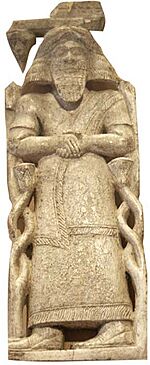Hazael facts for kids
Quick facts for kids Hazael |
|
|---|---|
| (El/God has seen) | |

Ivory inlay possibly depicting Hazael of Damascus
|
|
| King of Aram Damascus (King of Syria) | |
| Reign | 842–796 BC |
| Predecessor | Hadadezer |
| Successor | Ben-Hadad III |
| Occupation | Court official |
Hazael (/ˈheɪziəl/; Biblical Hebrew: חֲזָאֵל or חֲזָהאֵל, romanized: Ḥăzāʾēl) was a powerful king of Aram-Damascus, an ancient kingdom in what is now Syria. He ruled from about 842 to 796 BC. Under his leadership, Aram-Damascus grew into a large empire. This empire controlled big parts of modern-day Syria and the ancient Kingdom of Israel. Hazael is an important figure mentioned in the Bible and in ancient writings found by archaeologists.
Contents
Hazael: King of Aram-Damascus
Hazael in the Bible
The Bible first mentions Hazael in the book of 1 Kings. God tells Elijah, a special messenger called a prophet, to anoint Hazael as king of Syria. Years later, the Syrian king Ben-Hadad II was sick. He sent his official, Hazael, with gifts to Elisha, who was Elijah's successor.
Elisha told Hazael that the king would get better, but would die in another way. Elisha also predicted that Hazael would become king and cause trouble for the Israelites. Hazael denied he could do such things. Elisha then predicted that Hazael would indeed be king. Hazael returned to Damascus the next day. He told Ben-Hadad II that he would recover, but then Hazael suffocated the king and took power for himself.
During his rule, King Hazael led the Arameans in battles. He fought against the combined armies of Jehoram of Israel and Ahaziah of Judah. After defeating them, Hazael also fought off two attacks from the Assyrians. He took over Israelite land east of the Jordan River. He also captured the Philistine city of Gath. Hazael also tried to take Jerusalem, but he was not successful (2 Kings 12:17-18). The Bible mentions Hazael's death in 2 Kings 13:24.
The Tel Dan Stele
A large stone monument with writing on it was found at a place called Tel Dan. Most experts believe this writing was put there by Hazael. It describes his victory over the kings of Israel and Judah. This discovery helps us learn more about Hazael's time.
Recent digs at Tell es-Safi/Gath have shown clear signs of Hazael's attack. They found evidence of the siege and how Gath was conquered by his army. Studies of ancient magnetic fields in the soil suggest that other places like Tell Zeitah, Tel Rehov, and Horvat Tevet were also destroyed by Hazael's military campaigns.
Items Connected to Hazael
Bronze Plaques
Archaeologists have found decorated bronze plaques that were part of horse harnesses. These plaques have inscriptions that say they belonged to Hazael. They were found far away in Greece, at the Heraion of Samos and the temple of Apollo at Eretria. These plaques were likely given as special gifts to the gods.
The inscriptions on them say: "that which Hadad gave to our lord Hazael from 'Umq in the year that our lord crossed the River." The river mentioned is likely the Orontes. These plaques show a "Master of the animals" holding sphinxes or lions. They also show goddesses standing on the heads of lions. When Tiglath-Pileser III took Damascus in 733/2 BC, these valuable items became part of the loot. They eventually ended up in Greek hands.
Arslan Tash Ivories
In 1928, a team of French archaeologists found ivory decorations for a bed in Arslan Tash in northern Syria. One of these pieces has an ancient Aramaic inscription with Hazael's name on it. This suggests the bed belonged to King Hazael of Aram-Damascus. This inscription is known as KAI 232.
Some broken pieces of ivory also mentioning Hazael were found in Nimrud, Iraq.
See also
- List of biblical figures identified in extra-biblical sources
- Timeline of Syrian history

